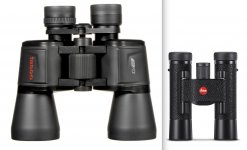Yes, probably the eye placement on the EL 8.5x42 is better than in the 8x32 ELSV, and probably eye position, FOV, and low light performance in the 10x50 WX are miles better than in the EL 8.5x42. Why don't you carry one?

The answer is simple: any item is a matter of the compromises you are ready to take: a shoe, a pencil, a car, you name it. In your threads and your rationale you usually chose one characteristic (being a Porro, or having big FOV, or high % light transmission) and make it stand above the rest. Well, that's perfectly OK if it works for you.
Back to your original post. Your question is a simple one "
Do you think an excellent 8x42 can be better than an alpha 8x32 optically? "
My simple answer, based on my personal experience is no, it is not. My elaborate answer can be found on my first reply, where I explain my experience exactly with those two kind of binoculars (8x42 Conquest HD vs 8x32 ELSV). Give me a nice 8x32 over a 8x42 everyday of the week.
So, "
is an excellent 8x42
better optically than a 8x32?". I don't know. As always, answers have many facets and there are endless points of view, and I've given you mine: in my case, the answer is no. Yes, a 8x42 surely is brighter in low light, but that is only a part of the everyday use (your question was not narrowed to low light, but to "optical excellence", whatever that means.
Let me give you an example following your reasoning style. For starters, most 8x32 have a wider FOV than their 8x42 counterparts. Take the two binoculars I'm always referring to: 8x42 Conquest HD and 8x32 ELSV. Surprise: 7,4º vs 8º FOV. How good is that? To follow the
film-noir-attorney-tone you usually use for questioning and getting the answer you want to get I could simply ask you:
What do you prefer, a 7,4º or a 8º FOV? And conclude, in pure
Dennis-fashionTM that a 8x32 is way better, because FOV is of outmost importance

(hey, I'm starting to like this game of yours!

).
Regarding your question about weight, yes, weight is of utmost importance for my intended use, since I usually use my binoculars on the move (and the simple and sad proof is that I sold my Conquest HD 8x42 because I just left it at home to avoid the burden of carrying its weight and bulk). For astro, since I do it from my balcony, I've enjoyed behemoths like the Fujinon FMT-SX 7x50 or the 8x56 Nighthunter, which I know you know and like, and I've enjoyed their great performance.
Glare is clearly the biggest fault of the 8x32 ELSV. However, as I said earlier, any item is a matter of compromise among its strengths and weaknesses and each one chooses their own, what he or she is ready to accept or not. I value the stunning view, size, weight, handling and comfort of the 8x32 ELSV way more than its glare issue (the same way I prefer the view through the 7x35 Retrovids better, but the viewing comfort is inexistent for me, and hence a deal-breaker). On the other hand, I found the weight, bulk and eye comfort problems in the 8x42 Conquest HD to have more weight (pun intended) than its better low light performance. So, there you have my answer: no, I don't think an excellent 8x42 is better than an alpha 8x32 (that's my personal opinion, and I don't expect anyone to agree with it).






